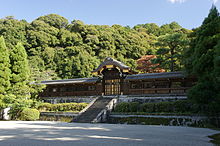Sennyū-ji
Sennyū-ji (泉涌寺),[1] formerly written as Sen-yū-ji (仙遊寺),[2] is a Shingon Buddhist temple and head of the Sennyū-ji sect in Higashiyama-ku in Kyoto, Japan.[3] For centuries, Sennyū-ji has been a mausoleum for noble families and members of the Imperial House of Japan. Located within the temple grounds are the official tombs of Emperor Shijō[4] and many of the emperors who came after him.[2]
History
Sennyū-ji was founded in the early


Tsukinowa no misasagi
Go-Momozono is also enshrined in Tsukinowa no misasagi along with his immediate Imperial predecessors since Emperor Go-Mizunoo -- Meishō, Go-Kōmyō, Go-Sai, Reigen, Higashiyama, Nakamikado, Sakuramachi, Momozono and Go-Sakuramachi.[9]
Nochi no Tsukinowa no Higashiyama no misasagi
Art
Sennyū-ji's large nehan-zu painting depicts Buddha on his death bed. This massive image (8 meters x 16 meters) is the largest in Japan. The image at nearby Tōfuku-ji is the second largest of its kind in Japan, measuring 7 meters x 14 meters. Both images are only rarely displayed, most recently in 2003 for three days only.[10]
See also
- Tsuki no wa no misasagi
- Tōfuku-ji
- Unryū-in
- List of Buddhist temples in Kyoto
- Thirteen Buddhist Sites of Kyoto
- List of National Treasures of Japan (ancient documents)
- Japanese Imperial Tombs
- For an explanation of terms concerning Japanese Buddhism, Japanese Buddhist art, and Japanese Buddhist temple architecture, see the Glossary of Japanese Buddhism.
Notes
- ^ A guide to the Sennyū-ji Temple 1972.
- ^ a b c Ponsonby-Fane 1956, p. 113.
- ^ a b "Sennyu-ji". www.buddhistravel.com. Archived from the original on 2011-07-08.
- ^ a b Ponsonby-Fane 1959, p. 422.
- ^ a b 概略 [Overview] (in Japanese). Sennyū-ji. Retrieved 8 December 2017.
- ^ https://kyoto.travel/en/shrine_temple/181.html
- ^ https://kyoto.travel/en/shrine_temple/181.html
- ^ a b "Sennyu-ji Temple, Kyoto". www.taleofgenji.org.
- ^ a b Ponsonby-Fane 1959, p. 423.
- ^ "Kansai: Who -- What: Giant Buddhas shown for three days only," Japan Times Online. March 9, 2003.
References
- OCLC 17483588.
- OCLC 182637732.
- OCLC 277269606.
- 京都御寺泉涌寺展 [A guide to the Sennyū-ji Temple] (in Japanese). Kyoto: Asahi Shimbun. 1972.
External links
- Senyū-ji website (in Japanese)
